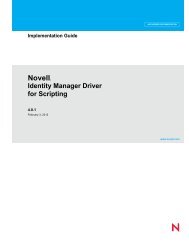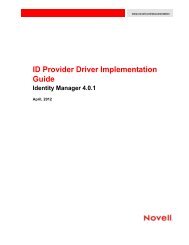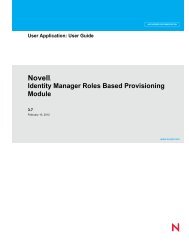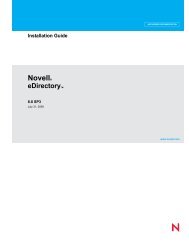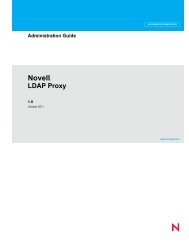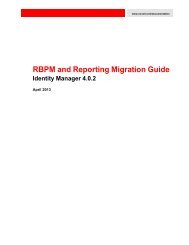Novell iManager 2.7.5 Administration Guide - NetIQ
Novell iManager 2.7.5 Administration Guide - NetIQ
Novell iManager 2.7.5 Administration Guide - NetIQ
You also want an ePaper? Increase the reach of your titles
YUMPU automatically turns print PDFs into web optimized ePapers that Google loves.
After the RBS collection is deleted, all users logging in to <strong>iManager</strong> enter in Assigned Access mode<br />
even though there is no RBS collection object in the tree.<br />
To switch back to Unrestricted mode (the default mode):<br />
1 In the Configure view, select <strong>iManager</strong> Server > Configure <strong>iManager</strong>.<br />
2 Select the RBS tab.<br />
3 Select the appropriate tree name in the RBS Tree List field, then click the minus button.<br />
4 Click Save.<br />
NOTE: When using <strong>iManager</strong> in Unrestricted mode, you typically see the following message on the<br />
<strong>iManager</strong> Home Page: Notice: Some of the roles and tasks are not available. Clicking<br />
View Details might display a Not supported by current authenticators message for several of<br />
the tasks, even though the tasks work correctly. This message is misleading, and <strong>iManager</strong> removes<br />
these messages after you configure RBS.<br />
6.2 RBS Configuration<br />
The RBS Configuration task provides complete control over RBS objects. It is a central place for<br />
managing and configuring RBS objects. You can list and modify RBS objects by type. The task also<br />
gives you useful information about the RBS system, such as the number of modules in a collection,<br />
how many are installed, how many are not installed, and how many are outdated. Some tasks let you<br />
operate on multiple objects simultaneously. For example, you can associate or disassociate multiple<br />
members from a role at the same time.<br />
From the Configure view, select Role‐Based Services > RBS Configuration to open the RBS Configuration<br />
page in the Content frame.<br />
The page includes two tabs:<br />
<strong>iManager</strong> 2.x Collection: Displays current RBS collections.<br />
<strong>iManager</strong> 1.x Collextions: Displays older RBS collections that you can either delete or migrate to<br />
<strong>iManager</strong> 2.x. If you select Migrate, a wizard steps you through the migration process.<br />
<strong>iManager</strong> displays only those collections you own, and includes the following information about<br />
each collection:<br />
• Module: Indicates the number of modules on the Web server that you are logged in to.<br />
• Installed: Indicates the number of modules that are currently installed.<br />
• Outdated: Indicates the number of outdated modules currently installed.<br />
• Not‐Installed: Indicates the number of modules that are available but not installed.<br />
To work with a particular collection, select it from the list. This opens a collection‐specific view, as<br />
shown in Figure 6‐2.<br />
Configuring and Customizing <strong>iManager</strong> 55




